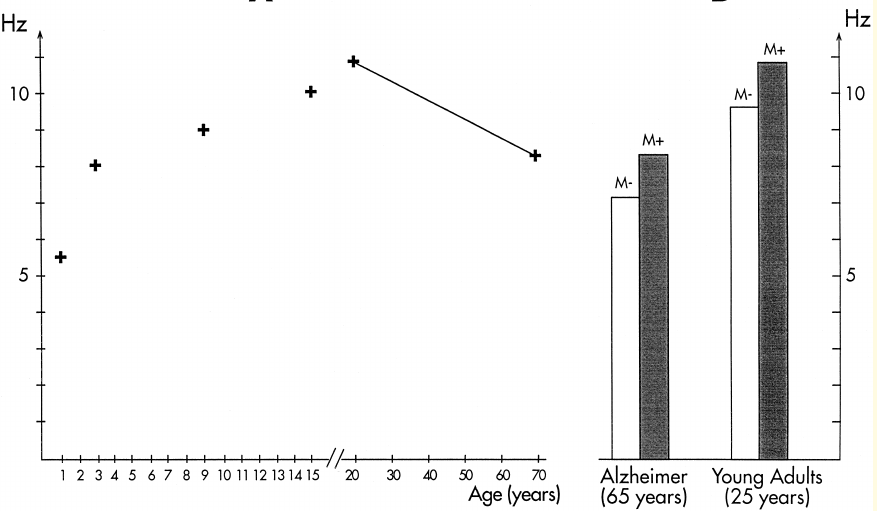@EEG alpha and theta oscillations reflect cognitive and memory performance a review and analysis (Klimesch 1998)
2022-03-16: reference:
@EEG alpha and theta oscillations reflect cognitive and memory performance a review and analysis (Klimesch, 1998) #
- TF = Transition frequency (the fine line between high theta and low alpha) varies from subject to subject. In some subjects, for example with neurodegenerative diseases, it can apparently be as low as 4 Hz with something like a peak alpha frequency of 7 Hz.
- (De)synchronization simply means increase or (de)crease in amplitude. Tl;dr:
- Good performance is related to two types of EEG phenomena, depending on the type of memory demands:
- (This study equates ‘phasic’ with immediate, while ’tonic’ really relates to the whole session’s level since it relates to personal individual differences, circadian rhythm, current level of fatigue, etc.)
- *Desynchro
-
Tonic Alpha waves increase and Theta waves decrease, #
- Or phasic Theta waves increase and Alpha waves decrease. Thus the two have a clear inverse relationship.
- This is with regards to memory though (especially the latter case as they state) where hippocampal theta is clearly very important. This may not apply so well for more general cognition, not that they’re saying otherwise.
- The reason that (upper) alpha desynchronization reflects ongoing cognition is not necessarily because it’s “fatiguing” but because it indicates various neural networks are operating at their own frequencies.
- (This study equates ‘phasic’ with immediate, while ’tonic’ really relates to the whole session’s level since it relates to personal individual differences, circadian rhythm, current level of fatigue, etc.)
-
Alpha frequency is defined in terms of peak frequency within the traditional range (7.5-12.5) (though it can go lower in neurodegenerative disease or very young children).
-
 (M+ = better memory) Upper alpha power increases and theta power decreases from early childhood to adulthood, declining with age.
(M+ = better memory) Upper alpha power increases and theta power decreases from early childhood to adulthood, declining with age.
-
-
…alpha frequency is related to the speed of information processing or reaction time. These results also suggest that alpha frequency should be related to Intelligence which indeed seems to be the case (2).
-
intraindividual or task related shifts in alpha frequency appear not to be related to the speed of information processing (76) because an asymmetric desynchroniza- tion in the broad alpha band (favoring the lower or upper band. will lead to a shift in power and, thus, to a distorted estimate of alpha frequency
- ??? By “shifts in alpha frequency” does he mean an increase in higher amplitudes at the expense of others? It was stated earlier that phasic alpha does not help, but rather theta.
-
Large alpha power which is correlated with a pronounced decrease in event-related band power and small theta power which is correlated with a pronounced increase in band power indicate good cognitive performance
- I guess this reminds me of the ‘principle’ about NMDARs put forth in @Memantine a NMDA receptor antagonist that improves memory by restoration of homeostasis in the glutamatergic system - too little activation is bad, too much is even worse (Parsons et al. 2007), how it relies on pronounced phasic activation (signal:noise) in order to function effectively.
- I mean you could say the statement quoted above is just saying you need a good ‘reservoir’ of alpha, which would negatively correlate with theta (if this paper has taught me anything) and after using it, theta necessarily increases after effort.
- But task-by-task (event-related desynchronization), like maybe on anki cards or something - I didn’t know it was that quick. But theta is of course highly implicated in hippocampal function… how? I reckon I will find out shortly
- WRONG! Ish, because anticipating the task in this ‘visual oddball task’ lowered lower alpha:

- Lower-1 reflects phasic alterness.
- Lower-2 reflects expectancy, desynchronizing only just before the stimulus but not the warning. Interesting how seamlessly these 3 frequencies are demonstrated with their own corresponding component stimuli
- Upper reflects semantic processes within actual task performance, thus would only desynchronize late poststimulus.
- WRONG! Ish, because anticipating the task in this ‘visual oddball task’ lowered lower alpha:
- But task-by-task (event-related desynchronization), like maybe on anki cards or something - I didn’t know it was that quick. But theta is of course highly implicated in hippocampal function… how? I reckon I will find out shortly
-
the theta band did not respond to semantic task demands at all.
- ???? Complete lie since good memory performance is correlated with higher theta synchronization.
-
Upper alpha (10~12) is more topographically restricted than lower alpha and is much more selective with what causes it to desynchronize.
-
The increase in upper alpha desynchronization during the semantic task in t5 is strictly localized over the left hemisphere.
-
semantic task demands particularly the retrieval of semantic information. are associated with a pronounced increase in the blood flow at left prefrontal regions
-
naming pictures of animals and tools (parts of the words used in the present study also represent animals, others such as weapons were similar to tools) was associated with bilateral activation of the Temporal Lobes and the calcarine region, the left Thalamus and the left anterior insularinferior frontal region